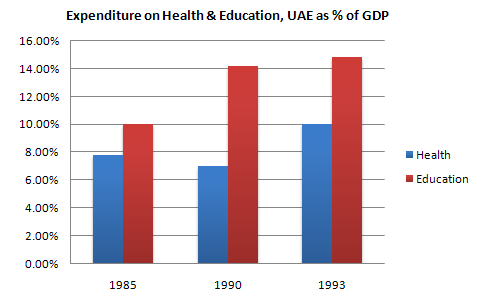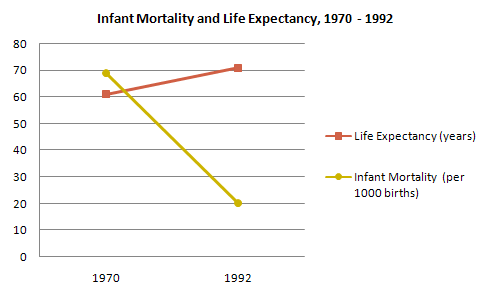» You should spend about 20 minutes on this task.
The graphs below show the Expenditure on Health & Education, UAE as percentages of GDP and Infant mortality and life expectancy.
Write a report for a university lecturer describing the information below.
» Write at least 150 words.


Model Answer 1:
The bar graph indicates the expenditure ratio of the UAE government in education and healthcare between 1985 and 1993, whereas the line graph compares life expectancy and infant mortality rate in the UAE in 1970 with that of 1992. Overall, UAE administrator spent more ratio of their budget on education than they did on health care. The improvement Emiratis achieved to prevent child death cases was remarkable.
As the bar chart suggests, the UAE administration spent one-tenth of their GDP in the health sector in 1985 and their spending on public health was roughly 2% lower than that. After 5 years, 14% of GDP went on education which was almost double than the expenditure in health division. Interestingly, the UAE authority spent less ratio of their GDP in public health in 1990 than they did in 1985 but it went up to 10% in 1993. The funds for education went as high as nearly 15% in 1993.
The line graph delineates that Emiratis people’s life expectancy was 60 years in 1970 and it was extended to just over 70 years after two decades. Infant mortality rate, on the other hand, was quite high in 1970 (70 child death in every thousand) and it improved significantly during 22 years when it went as low as 20 per thousand.
Sample Answer 2:
The graphs show the ratio of GDP spent on health and education sectors in the UAE from 1985 to 1993 and it also presents the infant mortality and life expectancy rates of this country from 1970 to 1992.
According to the bar chart, the UAE administrator spent around 8% on health care and 10% on the education of their total GDP. After 5 years, the expenditure on health decreased slightly while the expenditure on education increased by 4%. Finally, in 1993, the amount spent on both sectors grew and reached to 10% of GDP on healthcare and over 14% on education.
As depicted in the line graph, the life expectancy in the UAE was 60 years in 1970 while the infant mortality rate was 70 per thousand. After 22 years, both of these conditions improved and the life expectancy extended to 71 years while the infant mortality rate declined to 20 per thousand.
In summary, the UAE’s budget for health and education sector increased over the period and as a result, the infant mortality rate reduced and the life expectancy improved.
(Approximately 181 words)
(This model answer can be followed as an example of a very good answer. However, please note that this is just one example out of many possible approaches.)
Model Answer 3:
The bar graph compares the UAE government’s expenditures on health and education sectors in three different years with a 5 years gap while the line graph shows the infant mortality rate and citizens’ life expectancy from 1970 to 1992. As is evident, the UAE government spent more on healthcare and education in 1990 than they did in the past while citizens’ life expectancy enhanced along with declining the infant mortality rate.
As is given in the diagrams, the UAE government spent less than 8% of their GDP on healthcare in 1985 and just 10% on education. After 5 years, the spending on healthcare decreased slightly but increased dramatically in the education sector. In the final year, both sectors got priority and the spending on health sector increased to 10% while it was about 15% of the GDP in education.
The line graph represents that the percentage of spending in the UAE had a direct impact on their citizens’ life expectancy and infant’s mortality rate. While the life expectancy in the UAE was just 60 years in 1970, it increased to over 70 in 1992. On the other hand, the infant mortality rate decreased to just 20% in 1992 from the astonishing 70% in 1970.
Sample Answer 4:
The bar graph illustrates the expenditure on health and education sectors in the UAE, measured as the percentage of GDP, in three different years- 1985, 1990 and 1994 while the line graph demonstrates child mortality and life expectancy from 1970 to 1992. According to the diagram, investment in both health and education in the UAE grew over the time and infant mortality and life expectancy scenario improved.
As is presented, expense on public health in 1985 was nearly 8% of the GDP in the UAE, whereas it slightly decreased half a decade later. In 1993, however, the healthcare expense made up 10% of the total GDP. Education expenditure rose constantly from 1985 to 1993 and UAE’s expenditure in education was higher than that of healthcare. In 1985, one-tenth GDP went on the education sector and it grew as high as 15% after 8 years.
The line graph shows the infant mortality rates and citizens’ life expectancy between 1970 and 1992. It is evident that child death rate noticeably declined during the period from 70 deaths per thousand in 1970 to 20 per thousand is a great improvement indeed. Consequently, people’s life expectancy rose from 60 years to 70 years in just 22 years.
[Written by – Simone]
